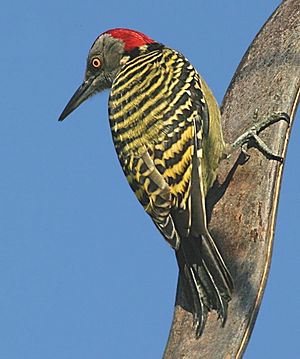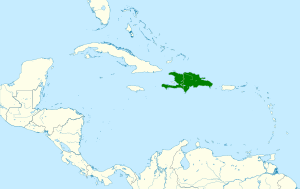Hispaniolan woodpecker facts for kids
Quick facts for kids Hispaniolan woodpecker |
|
|---|---|
 |
|
| In La Romana Province, Dominican Republic | |
| Conservation status | |
| Scientific classification | |
| Genus: |
Melanerpes
|
| Species: |
striatus
|
 |
|
The Hispaniolan woodpecker (Melanerpes striatus) is a special bird. It's a medium-sized woodpecker that lives only on the Caribbean island of Hispaniola. This island is shared by two countries: the Dominican Republic and Haiti.
Contents
What Does It Look Like?
The Hispaniolan woodpecker is a colorful bird. It has stripes of gold and black. It grows to be about 22 to 28 centimeters (9 to 11 inches) long.
Males, Females, and Young Birds
Adult male woodpeckers have a bright red top of the head (crown) and back of the neck (nape). They are also a bit bigger than the females. Their beaks are longer too.
The female woodpecker looks similar to the male. But she has a black crown instead of red. Her nape is red, just like the male's.
Young woodpeckers (juveniles) have a black crown. It has white and red spots. Their nape is orange, and their eyes are dark.
Colors and Markings
The upper part of their neck has black and white stripes. Their back and wings have bold black and gold stripes. The area above their tail is greenish-yellow. It has some red tips on the feathers. The top of their tail is black.
Underneath, their wings are grayish-brown. They have light spots and stripes. The underside of their tail is grey or olive green. Their face and throat are grey. Their belly area is buff, brown, or olive. It might have some dark streaks on the sides. Their eyes are yellow. Their beak is long, thin, and grey. Their legs are also grey.
Sounds They Make
These woodpeckers are quite noisy! They make many different sounds. You might hear them yapping, squeaking, or making rolling and nasal calls. They don't drum on trees very often.
Where Do They Live?
You can find the Hispaniolan woodpecker in both Haiti and the Dominican Republic. They mostly live in wooded areas.
Their Homes and Habitats
Their home range covers many different types of places on Hispaniola. They live in wet forests, dry forests, and forests with broadleaf trees. They also live in pine forests.
You can also find them in other spots. These include farms, areas with cactus plants, and mangrove swamps. They like grasslands, palm groves, and even city parks.
What Do They Eat?
Hispaniolan woodpeckers look for food in small, noisy groups. They eat many different things. Their diet includes insects, spiders, and scorpions. They also eat small lizards, fruits, seeds, and grains. Sometimes they even drink tree sap!
How They Find Food
They can catch flying insects right out of the air. If they find a big piece of food, they might hit it against a hard surface. This helps them break it into smaller pieces.
These woodpeckers usually look for food on the sides of tree trunks. They rarely search for food on the ground. This is because their food sources are usually high up in trees.
Food for Young Birds
Baby woodpeckers (nestlings) get a varied diet from their parents. Parents often bring them food that has been partly digested. But they also give their young fresh, whole food.
Are They Pests?
Sometimes, these woodpeckers are seen as a problem for farmers. In the Dominican Republic, they might eat from cacao plants. They also eat from other fruit trees. They don't eat the seeds inside the cacao plant. But the holes they make can let insects get in and damage the crop.
Social Life and Reproduction
Unlike most woodpeckers, the Hispaniolan woodpecker is a very social bird. They live in large groups called colonies. Many adult birds in the colony work together. They help protect their nesting area, like a bank or a tree.
Nesting Habits
There can be up to twenty pairs of birds in one colony. Several pairs might even nest in the same tree! They dig their nests inside tree trunks and branches.
When they leave a nest hole, other birds might use it. These include Hispaniolan amazons, Hispaniolan parakeets, and Hispaniolan trogons. Antillean piculets and golden swallows also use these old holes.
Breeding Season
These woodpeckers are thought to breed all year long. However, nesting usually starts in the spring. In some groups, breeding happens from March through August.
Both the male and female work together to dig the nest hole. They share the work evenly. Once the eggs are laid, both parents take turns sitting on them (incubating). They also both help feed the young once they hatch. A typical nest has four or five eggs.
How They Communicate
Hispaniolan woodpeckers use different movements to communicate. These are called visual displays.
Bill and Body Movements
They might use their beak in a special way. This is called a "bill display." It's thought to be a way to show they are upset or angry. They might use it to warn other birds to stay away from their territory or nest.
Body movements, like a "swinging" display, also show anger or agitation.
Greeting and Mating Displays
Two other displays are the "bowing" display and "dihedral flight." These are usually seen between a male and female. A breeding pair might greet each other at the nest by bowing. They move their head and beak up and down.
Dihedral flight is a glide-like pattern they use when flying. They often show this when their mate is nearby.
Molting Patterns
Hispaniolan woodpeckers shed their old feathers and grow new ones. This process is called molting. They molt in a pattern similar to woodpeckers in cooler climates.
They keep their main wing feathers (primary coverts) during their second molting cycle. They usually molt during their breeding season. This happens from mid-spring to mid-summer. This timing is common for birds that live in tropical areas. Both male and female woodpeckers have similar molting patterns for their flight feathers and body feathers.
See also
 In Spanish: Carpintero de La Española para niños
In Spanish: Carpintero de La Española para niños


